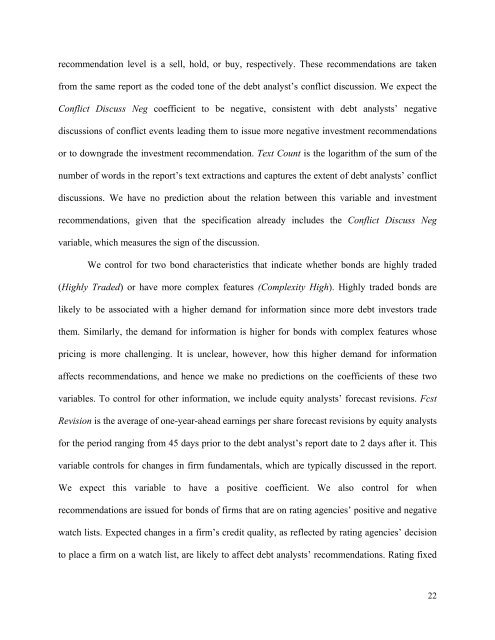Debt Analysts' Views of Debt-Equity Conflicts of Interest
Debt Analysts' Views of Debt-Equity Conflicts of Interest
Debt Analysts' Views of Debt-Equity Conflicts of Interest
You also want an ePaper? Increase the reach of your titles
YUMPU automatically turns print PDFs into web optimized ePapers that Google loves.
ecommendation level is a sell, hold, or buy, respectively. These recommendations are taken<br />
from the same report as the coded tone <strong>of</strong> the debt analyst’s conflict discussion. We expect the<br />
Conflict Discuss Neg coefficient to be negative, consistent with debt analysts’ negative<br />
discussions <strong>of</strong> conflict events leading them to issue more negative investment recommendations<br />
or to downgrade the investment recommendation. Text Count is the logarithm <strong>of</strong> the sum <strong>of</strong> the<br />
number <strong>of</strong> words in the report’s text extractions and captures the extent <strong>of</strong> debt analysts’ conflict<br />
discussions. We have no prediction about the relation between this variable and investment<br />
recommendations, given that the specification already includes the Conflict Discuss Neg<br />
variable, which measures the sign <strong>of</strong> the discussion.<br />
We control for two bond characteristics that indicate whether bonds are highly traded<br />
(Highly Traded) or have more complex features (Complexity High). Highly traded bonds are<br />
likely to be associated with a higher demand for information since more debt investors trade<br />
them. Similarly, the demand for information is higher for bonds with complex features whose<br />
pricing is more challenging. It is unclear, however, how this higher demand for information<br />
affects recommendations, and hence we make no predictions on the coefficients <strong>of</strong> these two<br />
variables. To control for other information, we include equity analysts’ forecast revisions. Fcst<br />
Revision is the average <strong>of</strong> one-year-ahead earnings per share forecast revisions by equity analysts<br />
for the period ranging from 45 days prior to the debt analyst’s report date to 2 days after it. This<br />
variable controls for changes in firm fundamentals, which are typically discussed in the report.<br />
We expect this variable to have a positive coefficient. We also control for when<br />
recommendations are issued for bonds <strong>of</strong> firms that are on rating agencies’ positive and negative<br />
watch lists. Expected changes in a firm’s credit quality, as reflected by rating agencies’ decision<br />
to place a firm on a watch list, are likely to affect debt analysts’ recommendations. Rating fixed<br />
22
















